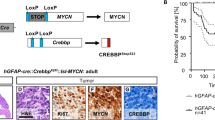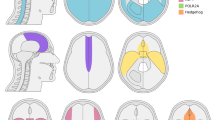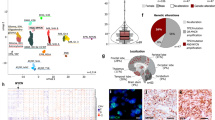Abstract
Aggressive variants of meningiomas (WHO grade II and III) represent up to 30% of those tumors that are among the most common primary central nervous system tumors in adults. Currently, there is no effective treatment for grade-II and -III meningiomas, the main treatment remaining surgical excision. Genetic studies have highlighted two main events associated with meningioma progression: an increase of chromosomal instability in tumors with NF2 inactivation and homozygous deletions or point mutations of the CDKN2AB locus. In this study we demonstrated that in mice, in addition to bi-allelic Nf2 inactivation, homozygous and heterozygous Adenovirus Cre-mediated Cdkn2ab deletions lead to increased meningioma frequency (72% and 50%, respectively) with a shorter latency (3.5 and 7.8 months, respectively) compared with control cohorts and induce grade II/III meningioma progression with an incidence of 34% and 28%, respectively. Moreover, Cdkn2ab inactivation in arachnoidal cells was associated with decreased senescence compared with Nf2−/− and wild-type arachnoidal cells in vitro. We have established three mouse meningioma cell lines and generated a syngenic orthotopic meningioma mouse model with 50–100% grade-II/III meningiomas after reimplantation. Comparative genomic hybridization of four meningiomas from Cdkn2ab homozygous mice and three cell cultures revealed the absence of unbalanced chromosomal segments in tumors and several chromosome imbalances in cell cultures. In addition, we were able to detect meningiomas by using bioluminescence and to evaluate tumor vascular permeability by dynamic magnetic resonance imaging. These results show that Nf2 and Cdkn2ab cooperate to promote meningioma progression in mice. The short latency of tumor development and the ability to derive grade II/III meningioma cell cultures are key aspects of this model to promote its use in pre-clinical drug testing.
This is a preview of subscription content, access via your institution
Access options
Subscribe to this journal
Receive 50 print issues and online access
$259.00 per year
only $5.18 per issue
Buy this article
- Purchase on Springer Link
- Instant access to full article PDF
Prices may be subject to local taxes which are calculated during checkout






Similar content being viewed by others

References
Louis D, Ohgaki H, Wiestler O, Cavenee W . WHO Classification of Tumours of the Central Nervous System 4th edn. IRAC Press, Lyon, 2007.
Aghi MK, Carter BS, Cosgrove GR, Ojemann RG, Amin-Hanjani S, Martuza RL et al. Long-term recurrence rates of atypical meningiomas after gross total resection with or without postoperative adjuvant radiation. Neurosurgery 2009; 64: 56–60 discussion.
Hanft S, Canoll P, Bruce JN . A review of malignant meningiomas: diagnosis, characteristics, and treatment. J Neurooncol. 2010; 99: 433–443.
Leone PE, Bello MJ, de Campos JM, Vaquero J, Sarasa JL, Pestana A et al. NF2 gene mutations and allelic status of 1p, 14q and 22q in sporadic meningiomas. Oncogene 1999; 18: 2231–2239.
Riemenschneider MJ, Perry A, Reifenberger G . Histological classification and molecular genetics of meningiomas. Lancet Neurol 2006; 5: 1045–1054.
Ruttledge MH, Sarrazin J, Rangaratnam S, Phelan CM, Twist E, Merel P et al. Evidence for the complete inactivation of the NF2 gene in the majority of sporadic meningiomas. Nat Genet 1994; 6: 180–184.
Al-Mefty O, Kadri PA, Pravdenkova S, Sawyer JR, Stangeby C, Husain M . Malignant progression in meningioma: documentation of a series and analysis of cytogenetic findings. J Neurosurg 2004; 101: 210–218.
Buschges R, Ichimura K, Weber RG, Reifenberger G, Collins VP . Allelic gain and amplification on the long arm of chromosome 17 in anaplastic meningiomas. Brain Pathol 2002; 12: 145–153.
Lamszus K, Vahldiek F, Mautner VF, Schichor C, Tonn J, Stavrou D et al. Allelic losses in neurofibromatosis 2-associated meningiomas. J Neuropathol Exp Neurol 2000; 59: 504–512.
Lopez-Gines C, Cerda-Nicolas M, Gil-Benso R, Callaghan R, Collado M, Roldan P et al. Association of loss of 1p and alterations of chromosome 14 in meningioma progression. Cancer Genet Cytogenet 2004; 148: 123–128.
Menon AG, Rutter JL, von Sattel JP, Synder H, Murdoch C, Blumenfeld A et al. Frequent loss of chromosome 14 in atypical and malignant meningioma: identification of a putative 'tumor progression' locus. Oncogene 1997; 14: 611–616.
Mihaila D, Jankowski M, Gutierrez JA, Rosenblum ML, Newsham IF, Bogler O et al. Meningiomas: loss of heterozygosity on chromosome 10 and marker-specific correlations with grade, recurrence, and survival. Clin Cancer Res 2003; 9: 4443–4451.
Goutagny S, Yang HW, Zucman-Rossi J, Chan J, Dreyfuss JM, Park PJ et al. Genomic profiling reveals alternative genetic pathways of meningioma malignant progression dependent on the underlying NF2 status. Clin Cancer Res 2010; 16: 4155–4164.
Kim WY, Sharpless NE . The regulation of INK4/ARF in cancer and aging. Cell 2006; 127: 265–275.
Sharpless NE, Ramsey MR, Balasubramanian P, Castrillon DH, DePinho RA . The differential impact of p16(INK4a) or p19(ARF) deficiency on cell growth and tumorigenesis. Oncogene 2004; 23: 379–385.
Krimpenfort P, Ijpenberg A, Song JY, van der Valk M, Nawijn M, Zevenhoven J et al. p15Ink4b is a critical tumour suppressor in the absence of p16Ink4a. Nature 2007; 448: 943–946.
Bostrom J, Meyer-Puttlitz B, Wolter M, Blaschke B, Weber RG, Lichter P et al. Alterations of the tumor suppressor genes CDKN2A (p16(INK4a)), p14(ARF), CDKN2B (p15(INK4b)), and CDKN2C (p18(INK4c)) in atypical and anaplastic meningiomas. Am J Pathol 2001; 159: 661–669.
Weber RG, Bostrom J, Wolter M, Baudis M, Collins VP, Reifenberger G et al. Analysis of genomic alterations in benign, atypical, and anaplastic meningiomas: toward a genetic model of meningioma progression. Proc Natl Acad Sci USA 1997; 94: 14719–14724.
Perry A, Banerjee R, Lohse CM, Kleinschmidt-DeMasters BK, Scheithauer BW . A role for chromosome 9p21 deletions in the malignant progression of meningiomas and the prognosis of anaplastic meningiomas. Brain Pathol 2002; 12: 183–190.
Korshunov A, Shishkina L, Golanov A . Immunohistochemical analysis of p16INK4a, p14ARF, p18INK4c, p21CIP1, p27KIP1 and p73 expression in 271 meningiomas correlation with tumor grade and clinical outcome. Int J Cancer 2003; 104: 728–734.
Ragel BT, Couldwell WT, Gillespie DL, Wendland MM, Whang K, Jensen RL . A comparison of the cell lines used in meningioma research. Surg Neurol 2008; 70: 295–307 discussion.
Kamijo T, Bodner S, van de Kamp E, Randle DH, Sherr CJ . Tumor spectrum in ARF-deficient mice. Cancer Res 1999; 59: 2217–2222.
Morrison JP, Satoh H, Foley J, Horton JL, Dunnick JK, Kissling GE et al. N-ethyl-N-nitrosourea (ENU)-induced meningiomatosis and meningioma in p16(INK4a)/p19(ARF) tumor suppressor gene-deficient mice. Toxicol Pathol 2007; 35: 780–787.
Kalamarides M, Niwa-Kawakita M, Leblois H, Abramowski V, Perricaudet M, Janin A et al. Nf2 gene inactivation in arachnoidal cells is rate-limiting for meningioma development in the mouse. Genes Dev 2002; 16: 1060–1065.
Kalamarides M, Stemmer-Rachamimov AO, Takahashi M, Han ZY, Chareyre F, Niwa-Kawakita M et al. Natural history of meningioma development in mice reveals: a synergy of Nf2 and p16(Ink4a) mutations. Brain Pathol 2008; 18: 62–70.
Collado M, Serrano M . Senescence in tumours: evidence from mice and humans. Nat Rev Cancer 2010; 10: 51–57.
James MF, Lelke JM, Maccollin M, Plotkin SR, Stemmer-Rachamimov AO, Ramesh V et al. Modeling NF2 with human arachnoidal and meningioma cell culture systems: NF2 silencing reflects the benign character of tumor growth. Neurobiol Dis 2008; 29: 278–292.
Jongsma J, van Montfort E, Vooijs M, Zevenhoven J, Krimpenfort P, van der Valk M et al. A conditional mouse model for malignant mesothelioma. Cancer Cell 2008; 13: 261–271.
Lyons SK, Meuwissen R, Krimpenfort P, Berns A . The generation of a conditional reporter that enables bioluminescence imaging of Cre/loxP-dependent tumorigenesis in mice. Cancer Res 2003; 63: 7042–7046.
Pistolesi S, Boldrini L, Gisfredi S, De Ieso K, Camacci T, Caniglia M et al. Angiogenesis in intracranial meningiomas: immunohistochemical and molecular study. Neuropathol Appl Neurobiol 2004; 30: 118–125.
Vautier J, Heilmann M, Walczak C, Mispelter J, Volk A . 2D and 3D radial multi-gradient-echo DCE MRI in murine tumor models with dynamic R*2-corrected R1 mapping. Magn Reson Med 2010; 64: 313–318.
Evans DG, Birch JM, Ramsden RT, Sharif S, Baser ME . Malignant transformation and new primary tumours after therapeutic radiation for benign disease: substantial risks in certain tumour prone syndromes. J Med Genet 2006; 43: 289–294.
Sotillo R, Schvartzman JM, Benezra R . Very CIN-ful: whole chromosome instability promotes tumor suppressor loss of heterozygosity. Cancer Cell 2009; 16: 451–452.
Collado M, Gil J, Efeyan A, Guerra C, Schuhmacher AJ, Barradas M et al. Tumour biology: senescence in premalignant tumours. Nature 2005; 436: 642.
Simon M, Park TW, Koster G, Mahlberg R, Hackenbroch M, Bostrom J et al. Alterations of INK4a(p16-p14ARF)/INK4b(p15) expression and telomerase activation in meningioma progression. J Neurooncol 2001; 55: 149–158.
Romagosa C, Simonetti S, Lopez-Vicente L, Mazo A, Lleonart ME, Castellvi J et al. p16(Ink4a) overexpression in cancer: a tumor suppressor gene associated with senescence and high-grade tumors. Oncogene 2011; 30: 2087–2097.
Puchner MJ, Hans VH, Harati A, Lohmann F, Glas M, Herrlinger U . Bevacizumab-induced regression of anaplastic meningioma. Ann Oncol 2010; 21: 2445–2446.
Goutagny S, Raymond E, Sterkers O, Colombani JM, Kalamarides M . Radiographic regression of cranial meningioma in a NF2 patient treated by bevacizumab. Ann Oncol 2011; 22: 990–991.
Lou E, Sumrall AL, Turner S, Peters KB, Desjardins A, Vredenburgh JJ et al. Bevacizumab therapy for adults with recurrent/progressive meningioma: a retrospective series. J Neurooncol 2012; 109: 63–70.
Loveless ME, Lawson D, Collins M, Nadella MV, Reimer C, Huszar D et al. Comparisons of the efficacy of a Jak1/2 inhibitor (AZD1480) with a VEGF signaling inhibitor (cediranib) and sham treatments in mouse tumors using DCE-MRI, DW-MRI, and histology. Neoplasia 2012; 14: 54–64.
Gaya A, Daley F, Taylor NJ, Tozer G, Qureshi U, Padhani A et al. Relationship between human tumour angiogenic profile and combretastatin-induced vascular shutdown: an exploratory study. Br J Cancer 2008; 99: 321–326.
Acknowledgements
We thank A Berns for Ink4ab−/+ mutant mice, M Pla and staff of the Institut Universitaire d’Hematologie (IUH), Universite Paris 7, for mouse housing. We also thank J Calderaro and G Morcrette for their help in additional pathological analyses. This work was supported by Grants from the Association pour la Recherche sur le Cancer (subvention fixe and funding to MP), Ligue Nationale contre le Cancer-comité Paris, Fondation Anber, Association Neurofibromatoses et Recklinghausen (to ECT and NK) and Inserm.
Author information
Authors and Affiliations
Corresponding author
Ethics declarations
Competing interests
The authors declare no conflict of interest.
Additional information
Supplementary Information accompanies the paper on the Oncogene website
Supplementary information
Rights and permissions
About this article
Cite this article
Peyre, M., Stemmer-Rachamimov, A., Clermont-Taranchon, E. et al. Meningioma progression in mice triggered by Nf2 and Cdkn2ab inactivation. Oncogene 32, 4264–4272 (2013). https://doi.org/10.1038/onc.2012.436
Received:
Revised:
Accepted:
Published:
Issue Date:
DOI: https://doi.org/10.1038/onc.2012.436
Keywords
This article is cited by
-
Respective roles of Pik3ca mutations and cyproterone acetate impregnation in mouse meningioma tumorigenesis
Cancer Gene Therapy (2023)
-
Transcriptome signatures associated with meningioma progression
Acta Neuropathologica Communications (2019)
-
Selective vulnerability of the primitive meningeal layer to prenatal Smo activation for skull base meningothelial meningioma formation
Oncogene (2018)
-
Development of patient-derived xenograft models from a spontaneously immortal low-grade meningioma cell line, KCI-MENG1
Journal of Translational Medicine (2015)
-
Deficiency of the protein-tyrosine phosphatase DEP-1/PTPRJ promotes matrix metalloproteinase-9 expression in meningioma cells
Journal of Neuro-Oncology (2015)


